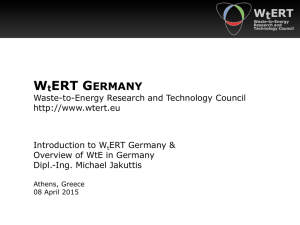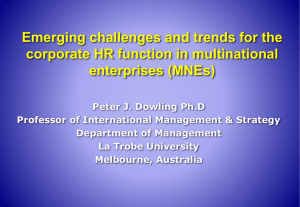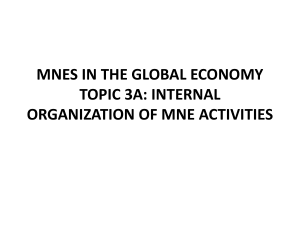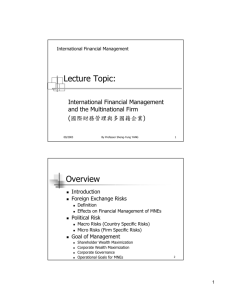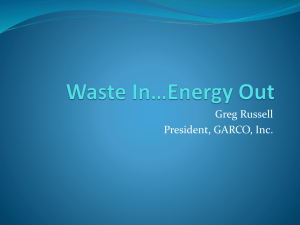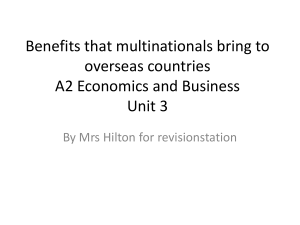ENERGY FROM MUNICIPAL WASTE : MYTH vs
advertisement
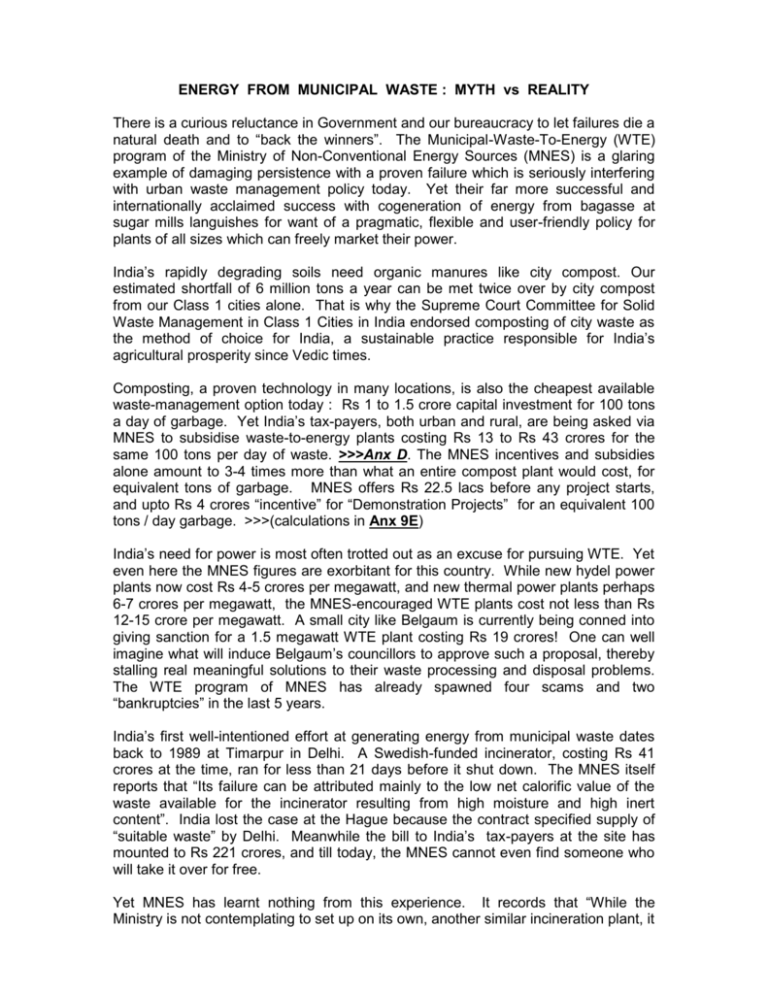
ENERGY FROM MUNICIPAL WASTE : MYTH vs REALITY There is a curious reluctance in Government and our bureaucracy to let failures die a natural death and to “back the winners”. The Municipal-Waste-To-Energy (WTE) program of the Ministry of Non-Conventional Energy Sources (MNES) is a glaring example of damaging persistence with a proven failure which is seriously interfering with urban waste management policy today. Yet their far more successful and internationally acclaimed success with cogeneration of energy from bagasse at sugar mills languishes for want of a pragmatic, flexible and user-friendly policy for plants of all sizes which can freely market their power. India’s rapidly degrading soils need organic manures like city compost. Our estimated shortfall of 6 million tons a year can be met twice over by city compost from our Class 1 cities alone. That is why the Supreme Court Committee for Solid Waste Management in Class 1 Cities in India endorsed composting of city waste as the method of choice for India, a sustainable practice responsible for India’s agricultural prosperity since Vedic times. Composting, a proven technology in many locations, is also the cheapest available waste-management option today : Rs 1 to 1.5 crore capital investment for 100 tons a day of garbage. Yet India’s tax-payers, both urban and rural, are being asked via MNES to subsidise waste-to-energy plants costing Rs 13 to Rs 43 crores for the same 100 tons per day of waste. >>>Anx D. The MNES incentives and subsidies alone amount to 3-4 times more than what an entire compost plant would cost, for equivalent tons of garbage. MNES offers Rs 22.5 lacs before any project starts, and upto Rs 4 crores “incentive” for “Demonstration Projects” for an equivalent 100 tons / day garbage. >>>(calculations in Anx 9E) India’s need for power is most often trotted out as an excuse for pursuing WTE. Yet even here the MNES figures are exorbitant for this country. While new hydel power plants now cost Rs 4-5 crores per megawatt, and new thermal power plants perhaps 6-7 crores per megawatt, the MNES-encouraged WTE plants cost not less than Rs 12-15 crore per megawatt. A small city like Belgaum is currently being conned into giving sanction for a 1.5 megawatt WTE plant costing Rs 19 crores! One can well imagine what will induce Belgaum’s councillors to approve such a proposal, thereby stalling real meaningful solutions to their waste processing and disposal problems. The WTE program of MNES has already spawned four scams and two “bankruptcies” in the last 5 years. India’s first well-intentioned effort at generating energy from municipal waste dates back to 1989 at Timarpur in Delhi. A Swedish-funded incinerator, costing Rs 41 crores at the time, ran for less than 21 days before it shut down. The MNES itself reports that “Its failure can be attributed mainly to the low net calorific value of the waste available for the incinerator resulting from high moisture and high inert content”. India lost the case at the Hague because the contract specified supply of “suitable waste” by Delhi. Meanwhile the bill to India’s tax-payers at the site has mounted to Rs 221 crores, and till today, the MNES cannot even find someone who will take it over for free. Yet MNES has learnt nothing from this experience. It records that “While the Ministry is not contemplating to set up on its own, another similar incineration plant, it is of the view that if some entrepreneurs come forward to invest in one… there is no reason not to support such an effort” through exorbitant subsidies at Indian citizens’ expense. What does it take to get bureaucrats to abandon unsuccessful policies? Incineration is being phased out or banned world-wide as air-quality standards are tightened. Hence the push by foreign companies to peddle incinerators and WTE plants in countries like India with less stringent environmental standards and a very low level of enforcement of the standards that do exist. The most damaging aspect of MNES subsidies for failed and inappropriate technologies like WTE is that it sends wrong signals to cities who are not very well informed about available choices. Their exorbitant subsidies merely reinforce the prevailing tendency to opt for unproven capital-expensive “high-tech” solutions while ignoring our traditional strengths and the success of low-tech low-cost options like composting which are highly successful and eco-friendly but unglamorous. It is time that we demand accountability from our decision-makers. Of the 33 feasibility studies funded by MNES since 5 years, not a single plant is yet working successfully. Let there be an end to promotion of any new WTE efforts until at least two plants in India are running near installed capacity for at least one year. There is no doubt that cities must invest in hygienic waste-processing of their urban solid wastes. Most cities barely have the funds even for waste collection and transport. But why subsidise the profitability of a capital-intensive industry that is intrinsically unviable? If at all subsidies have to be given, why back unproven technologies with phenomenal costs and neglect proven and beneficial ones? Central funds allocated to MNES for providing WTE subsidies and incentives can instead be far better used to help cities procure waste processing sites and install compost plants. Let us evolve Indian solutions for Indian problems. WTE, mostly by “burn” technologies was adopted in the past in developed countries where a consumerist life-style and lack of waste-pickers leaves them with urban wastes averaging only 16-24% by weight of biodegradables and the rest of it mostly packaging waste. Indian wastes, in contrast, are 60% biodegradable as they leave our homes, going up to 80% after waste-pickers remove recyclables which are burnt in the West. Now burning is being phased out there too. In India, anaerobic digestion to produce bio-gas (and then power) is feasible with food wastes free of plastics and ash. But successful solutions to this option will only develop if they are basically self-sustaining and economically viable. Subsidies will kill this effort. A small-scale experiment with bio-methanation of canteen waste at BEL Bangalore is successful because the gas is used by their canteen itself. A similar subsidy-dependent plant at a Pune market failed when an external buyer of the biogas found bottled LPG more economical and stopped purchases. There is an important lesson in this. If we want any waste-management process to succeed here, we must allow for survival of the fittest technologies in the Indian market climate. Ever-increasing external support is counter-productive. 1.9.2001 almitrapatel@rediffmail.com

